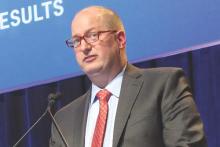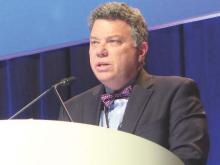SAN FRANCISCO – Hypofractionated radiation therapy, which delivers fewer, larger fractions relative to conventional radiation therapy, can be considered a new standard of care for localized prostate cancer, according to a pair of phase III noninferiority randomized trials reported at the Genitourinary Cancers Symposium.
The Radiation Therapy Oncology Group’s 0415 trial, conducted among men with low-risk disease, found that the 5-year rate of disease-free survival with a 70-Gy hypofractionated regimen was noninferior to that with a conventional regimen (86% vs. 85%). And a trial conducted by the U.K. CHHiP Trial Management Group among men with mainly intermediate-risk disease found that the 5-year rate of freedom from biochemical failure or prostate cancer recurrence with a 60-Gy hypofractionated regimen was noninferior to that with a conventional regimen (90.6% vs. 88.3%).
The trade-offs were small increases in the rates of some gastrointestinal and genitourinary toxicities with the hypofractionated regimens.
“Both of these trials now clearly establish that modest hypofractionated regimens are noninferior for biochemical failure, with modest to no change in toxicity. This is probably ready for prime time,” contended invited discussant Dr. Daniel A. Hamstra, a radiation oncologist with Texas Oncology in Irving. “Hypofractionation provides a cost- and resource-effective treatment that is easier and more convenient for patients.”
Among the points yet to be ironed out are identification of the optimal regimen and implementation of hypofractionation in the United States, he noted; uptake of hypofractionated radiation therapy in breast cancer has been slow, even though research there is about 5 to 10 years ahead of that in prostate cancer. “It will be intriguing to see what happens in the United States, whether or not this type of modest hypofractionation takes off,” he said at the symposium, sponsored by the American Society of Clinical Oncology, ASTRO, and the Society of Urologic Oncology.
RTOG 0415 trial
In the first trial, NRG Oncology’s RTOG 0415, investigators led by Dr. W. Robert Lee, a radiation oncologist at Duke University, Durham, N.C., randomized 1,115 men with low-risk prostate cancer to a conventional regimen (73.8 Gy given in 41 fractions over 8.2 weeks) or a hypofractionated regimen (70 Gy given in 28 fractions over 5.6 weeks). None received androgen suppression.
With a median follow-up of 5.8 years, the 5-year rate of disease-free survival (the trial’s primary endpoint) was 85% with conventional radiation therapy and 86% with hypofractionated radiation therapy. The absolute difference of 1% and the hazard ratio of 0.85 in favor of hypofractionation fell well within the predefined noninferiority margins of 7.65%, and 1.52, respectively.
The 5-year rates of biochemical recurrence were 8% with conventional radiation and 6% with hypofractionated radiation (hazard ratio, 0.77).
The two regimens did not differ significantly with respect to the rates of grade 3 or 4 early gastrointestinal and genitourinary adverse events. The hypofractionated regimen was associated with a higher rate of late gastrointestinal adverse events (P = .002), driven by more grade 2 events (18.3% vs. 11.4%), and a trend toward a higher rate of late genitourinary adverse events (P = .06), also driven mainly by more grade 2 events (26.2% vs. 20.5%).
“In men with low-risk prostate cancer, 70 Gy in 28 fractions is not inferior to 73.8 Gy in 41 fractions, albeit with a slight increase in grade 2 GI or GU toxicity,” Dr. Lee concluded. “It will be of great interest to determine if the small increase in grade 2 toxicity is manifest in patient-reported quality of life.”
When asked by an attendee whether the evidence from the two trials is sufficient to make hypofractionation standard of care, he said, “If you have a regimen that has been demonstrated in multiple phase III studies to be better or equivalent, then that can be considered a standard of care.”
Dr. Lee speculated that concerns that 5 years is not a sufficient follow-up may stem from past events in the field. “It’s perhaps related to the worry that radiation oncology really deservedly has about large dose per fraction given our history in the ‘70s and ‘80s when we tried to do things quicker. But if you remember, those toxicities were seen very early,” he elaborated.
“And my question back is, how many patients for how long do you need?” he said, given the more than 4,000 patients with 5-year follow-up in the two trials reported, plus an additional 1,700 expected from a similar Canadian study shortly. “How many patients are enough? Do you need 10,000 patients for 15 years?”
CHHiP trial



